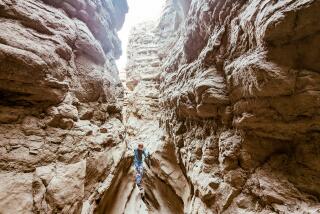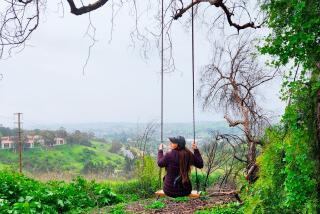‘A Jillion Names’ for a Mountain, but Just 1 Stuck
- Share via
The U.S. Geological Survey doesn’t accept Saddleback Mountain.
“There is no listing for a Saddleback on our maps (of Orange County),” confirmed Gerhard Krohn of the survey’s National Cartographic Information Center in Reston, Va.
Krohn, however, said the survey does record and recognize the twin peaks of the county’s Saddleback--Santiago and Modjeska. Krohn said both protuberances are officially listed as peaks, not individual mountains.
Webster’s New Geographical Dictionary, published by Merriam-Webster Inc. of Springfield, Mass., lists three mountains named Saddleback:
A mountain simply called Saddleback but also known as Blencathara is listed as being in the lake district of northwest England, 4 1/2 miles northeast of Keswick. It is 2,847 feet tall.
There is a Saddleback Mountain, elevation 4,116 feet, in Franklin County, Maine, near the Rangeley Lakes.
A second Eastern U.S. Saddleback Mountain is listed as being in the Adirondack Mountains of New York state’s Essex County. That one is 4,530 feet in elevation.
The twin peaks of Orange County’s unofficial Saddleback Mountain are both taller than the three Saddlebacks listed in the geographical dictionary. Modjeska Peak, the northern end of the saddle, is 5,496 feet tall, according to the U.S. Geological Survey. Santiago Peak, the saddle’s southern end, rises 5,687 feet.
In a book originally published in the 1930s but reissued in the 1970s, author Terry E. Stephenson wrote of the history of the county’s Saddleback. In the book, called “Shadows of Old Saddleback,” Stephenson noted: “Though Old Saddleback is made up of two peaks, the crests of which lie almost exactly a mile apart, to the old-timers it was always one mountain, and to the casual observer of today it appears as one mountain.”
Current-day county historian Jim Sleeper said his research indicates that English-speaking settlers of the county first started calling the twin peaks Old Saddleback sometime in the 1870s, “when the Santa Ana Valley was being settled.”
Sleeper noted, as did Stephenson in his book, that the county’s Saddleback has had many names in the past.
“It’s had a jillion names, starting with the Indians,” Sleeper said.
Stephenson’s book noted that in 1861, state geologist Josiah Dwight Whitney (for whom California’s Mt. Whitney is named) climbed the peaks now jointly known as Saddleback. Whitney dubbed the twin peaks “Mt. Downey,” in honor of California’s governor of that time. That name, however, did not last and never became official.
Portola Passed Mountain
Stephenson’s book also noted that the Portola expedition in 1769--the first European explorers to trek past Saddleback--apparently did not give it a name. The Spanish explorers, however, dubbed a creek flowing from the twin peaks as “Santiago.” It remains Santiago Creek today. Some Spanish- and English-speaking settlers later referred to the twin peaks as Santiago Mountain, the book said.
But other settlers called the twin-peaked landmark Trabuco Mountain, after the nearby canyon. One of the Portola expedition soldiers in 1769 lost a blunderbuss--in Spanish, a trabuco --in the canyon.
About 1900, surveyors from the U.S. Geological Survey climbed the county’s twin peaks. They named the tallest Santiago Peak--the official name to this day. The northern peak was left unnamed, but in 1909, following the death of famed Polish actress Madame Modjeska, who had settled in Orange County, a movement began to name the peak for her. Modjeska Peak did not become officially recognized by the U.S. government until 1961, according to Krohn of the National Cartographic Information Center.
Stephenson, in his book, noted: “The name (Saddleback) has never appeared on any map. It is just as well. No such thing as lettered wording can measure the meaning of the big mountain to those who have lived their lives within its shadow.”
More to Read
Sign up for The Wild
We’ll help you find the best places to hike, bike and run, as well as the perfect silent spots for meditation and yoga.
You may occasionally receive promotional content from the Los Angeles Times.






